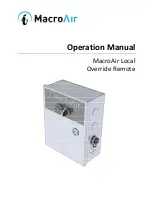
© Munters Corporation, January 2020
18
QM1086r8
Winterizing
6.
In most climates, it is probable that the ventilation system will never need to operate at a total capacity during
the colder winter months. Consequently, it is advisable to “winterize” those fans which will not be used in cold
weather to avoid unnecessary heat loss and condensation.
To winterize, turn fan control “off”. Install the insulated closure panel over the fan intake. If you don’t have an
insulated closure panel, a piece of rigid insulation material can be used. Remember the insulation panel must
be removed before warmer weather returns.
NOTE:
At least one single speed fan should be left uncovered and with power available to provide air
movement in the event of variable speed control difficulties.
6.1 Winterizing
6.2 Winter Weather Protection
To prevent cone or fan damage from snow or ice sliding off building roof, weather protection must be
provided. A weather shelter may be constructed to cover the entire fan,
See Figure 15,
or snow guards may
be placed on the roof,
See Figure 16.
Building
Wall
Provide Weather
Shelter Over Fans
6" Min.
Fan with
Discharge Cone
Figure 15
Snow Guards located
per manufacturers
recommendations*
Ceiling
Figure 16
Note:
Snow guards are designed to prevent sudden, dangerous snow
and ice slides when attached to the building roof according to
manufacturers recommendations. The supplier listing above is given
as a reference only. Munters does not endorse any specific snow
guard product and no performance warranty is implied.
Munters Product and System
Warranties do not cover cone or fan
damage from external sources.
IMPORTANT
!
Snojax, Inc.
800-766-5291
717-697-2452
www.snojax.com
Polar Blox
800-298-4328
814 629-9090
www.polarblox.com
LM Curbs
800-284-1412
903 759-3598
www.lmcurbs.com
Alpine Snow Guards
888-766-4273
888-766-9994
www.alpinesnowguards.com
*Snow Guard Suppliers
Company Name
Phone No.
Fax No.
Web Site
Fan with
Discharge
Cone







































